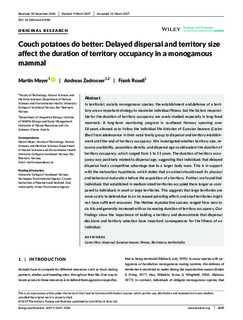| dc.contributor.author | Mayer, Martin | |
| dc.contributor.author | Zedrosser, Andreas | |
| dc.contributor.author | Rosell, Frank | |
| dc.date.accessioned | 2018-02-23T10:23:58Z | |
| dc.date.available | 2018-02-23T10:23:58Z | |
| dc.date.created | 2017-12-30T17:34:58Z | |
| dc.date.issued | 2017 | |
| dc.identifier.citation | Ecology and Evolution. 2017, 7 (12), 4347-4356. | nb_NO |
| dc.identifier.issn | 2045-7758 | |
| dc.identifier.uri | http://hdl.handle.net/11250/2486692 | |
| dc.description.abstract | In territorial, socially monogamous species, the establishment and defense of a terri - tory are an important strategy to maximize individual fitness, but the factors responsi - ble for the duration of territory occupancy are rarely studied, especially in long- lived mammals. A long- term monitoring program in southeast Norway spanning over 18 years allowed us to follow the individual life histories of Eurasian beavers ( Castor fiber ) from adolescence in their natal family group to dispersal and territory establish - ment until the end of territory occupancy. We investigated whether territory size, re - source availability, population density, and dispersal age could explain the duration of territory occupancy, which ranged from 1 to 11 years. The duration of territory occu - pancy was positively related to dispersal age, suggesting that individuals that delayed dispersal had a competitive advantage due to a larger body mass. This is in support with the maturation hypothesis, which states that an animal should await its physical and behavioral maturation before the acquisition of a territory. Further, we found that individuals that established in medium- sized territories occupied them longer as com - pared to individuals in small or large territories. This suggests that large territories are more costly to defend due to an increased patrolling effort, and small territories might not have sufficient resources. The lifetime reproductive success ranged from zero to six kits and generally increased with an increasing duration of territory occupancy. Our findings show the importance of holding a territory and demonstrate that dispersal decisions and territory selection have important consequences for the fitness of an individual. | nb_NO |
| dc.language.iso | eng | nb_NO |
| dc.rights | Navngivelse 4.0 Internasjonal | * |
| dc.rights.uri | http://creativecommons.org/licenses/by/4.0/deed.no | * |
| dc.title | Couch potatoes do better: Delayed dispersal and territory size affect the duration of territory occupancy in a monogamous mammal | nb_NO |
| dc.type | Journal article | nb_NO |
| dc.type | Peer reviewed | nb_NO |
| dc.description.version | publishedVersion | nb_NO |
| dc.rights.holder | The Authors | nb_NO |
| dc.source.pagenumber | 4347-4356 | nb_NO |
| dc.source.volume | 7 | nb_NO |
| dc.source.journal | Ecology and Evolution | nb_NO |
| dc.source.issue | 12 | nb_NO |
| dc.identifier.doi | 10.1002/ece3.2988 | |
| dc.identifier.cristin | 1533061 | |
| cristin.unitcode | 222,58,1,0 | |
| cristin.unitname | Institutt for natur, helse og miljø | |
| cristin.ispublished | true | |
| cristin.fulltext | original | |
| cristin.qualitycode | 1 | |

